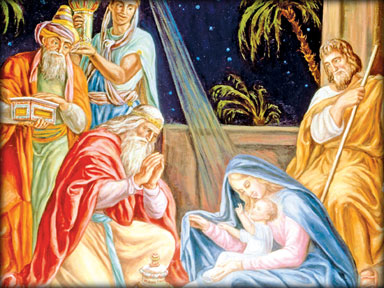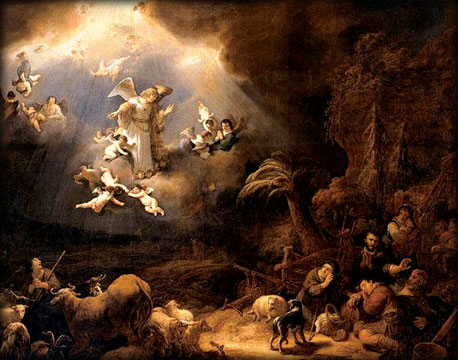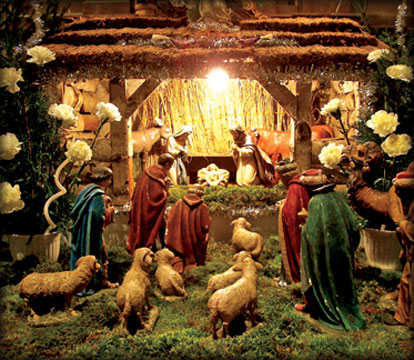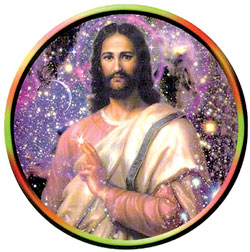 |
|
Christ Jesus Christ was
born on Christmas day |
Christmas and the Cosmic Christ
Rev. Fr. Mervyn Fernando
For most Christians, the external festivities of Christmas -
crib-making, decorations, Christmas cards, shopping, carol-singing and
cake-making - take centre-stage, throwing the real significance of the
Incarnation - God become Man, the divine become human - into the
shadows. The literally mind-boggling significance of the event is
trivialised. If God became matter in Christ, the whole material cosmos -
the heavens and the earth - become incorporated into Christ – divinised.
The true nature of God is laid bare in His self-emptying into the
human condition, to elevate us into the divine. The liturgical prayer of
the Offertory (when water is poured into the wine) tells us that God
became man that men may become gods.
This rich in-depth reality is captured in the figure of the Cosmic
Christ. Though it is not very familiar to most Christians today, it has
its sources in both the Old and New Testaments; it flourished in the
mystical tradition of the early Church, as exemplified in Gregory of
Nazianzus, Clement of Alexandra, Origen and others.
In the early Middle Ages, the flag-bearer was St. Francis of Assisi.
However, it got obscured in the late Middle Ages when the open-ended
theology of St. Thomas Aquinas, himself a mystic, degenerated into the
rigid structures of Scholasticism. There were, however, a few lone
voices such as those of Meister Eckhart, Hildegard of Bingen, Julian of
Norwich and Angelus Silesius - candles in the darkness. Then the
pervasive influence of the Enlightenment and the scientific Rationalism
in the 18th and 19th centuries was naturally hostile to any culture of
mysticism.
 |
|
A Govert Flinck painting which shows
angels announcing the Birth of Christ to the shepherds |
Even in biblical studies of that time, the pre-occupation was with
the quest of the historical Jesus. However, providentially, the face of
the Cosmic Christ has been emerging from obscurity in the latter half of
the 20th century, its most articulate voice being that of the
scientist-mystic, Teilhard de Chardin.
The limitations of a short article like this do not permit a full
explicitation of the sources. However, briefly:
In the Old Testament, the Cosmic Christ was pre-figured as cosmic
wisdom. In the Book of Job, the question is asked: “Where does wisdom
come from?”(Job, 28/12) and in Baruch, wisdom is celebrated as the
divine attribute by which God governs the world (Bar. 3/9-4/4). The Book
of Proverbs explicitly personifies that wisdom as follows:
“Yahweh created me when His purpose first unfolded
Before the oldest of his works
From everlasting I was firmly set
From the beginning, before earth came into being…..
Before the mountains were settled,
Before the hills I came to birth……
When he fixed the heavens firm, I was there” (Prov. 8/22-26)
And in the Book of Sirach:
“Alone I encircled the vault of the sky
and I walked on the bottom of the deeps
Over the waves of the sea and over the whole earth
And over every people and nation I have held sway….
From eternity in the beginning, he created me
And for eternity I shall remain” (Sir. 24/5-6, 9,26)
 |
|
A Nativity scene |
The Book of Wisdom tells us that Wisdom “pervades and permeates all
things” (8/24); She is “a breath of the power of God” and “a reflection
of the eternal light, untarnished mirror of God’s active power, image of
His goodness” (7/25,26).
New Testament
Coming to the New Testament (passing over other references in the Old
Testament), the very explicit statements of the Cosmic Christ are found
in the Epistles of St. Paul. I shall cite just two of them:
“He is the image of the invisible God, the first-born of all
creation; for in him were all things created, in heaven and on earth,
visible and invisible, whether thrones or dominions or principalities or
authorities - all things were created through him and for him. He is
before all things, and in him all things hold together. He is the
first-born from the dead, that in everything he might be pre-eminent.
For in him all the fullness of God was pleased to dwell, and through him
to reconcile to himself all things, whether on earth or in heaven,
making peace by his death on the cross” (Col. 1/15-20).
“For God has made known to us in all wisdom and insight the mystery
of the divine will, according to the divine purpose which God set forth
in Christ as a plan for the fullness of time, to unite all things
Christ, things in heaven and things on earth” (Eph 1/3-4, 9-10).
To conclude, I shall cite the well-known passage in St. John’s
Gospel. The Prologue situates Jesus’ life and ministry in a cosmological
context. It celebrates Christ as the Logos or Word of God, as well as
the wisdom of God present with God at the creation of the world. This
text is very probably from an early Christian hymn:
Beginning
 |
|
The Cosmic Christ |
“In the beginning was the word, the Word was with God and the Word
was God. This Word was with God in the beginning; Through him all things
came to be, not one thing had its beginning, but through him, all that
came to be had life in him, and that light was the light of people, a
light that shines in the dark, a light that darkness could not
overpower” (Jn. 1/1-5).
Even from this brief introduction to the Cosmic Christ, it is clear
how much our understanding of the Incarnation, of Christ in matter, in
Creation, in “the heavens and the earth” can be enlarged, far beyond the
Jesus of the Catechism. Religious education of both children and adults
still remains, despite some recent cosmetic changes, a matter of the
head - cognitive and conceptual (religious knowledge).
The mystical dimension, which relates directly to the heart,
feelings, imagination, aesthetic perception - all of which are directly
conducive to the experience of the divine, has been pushed to the
background. The historical event of the birth of Jesus opens an
all-embracing vista of God’s presence and action in the world in cosmic
dimensions of space and time, a vista which resonates with the fantastic
new discoveries about the Cosmos - its origins, structure, dynamics and
exciting cosmological speculation based on them.
Courtesy: The Messenger
|

